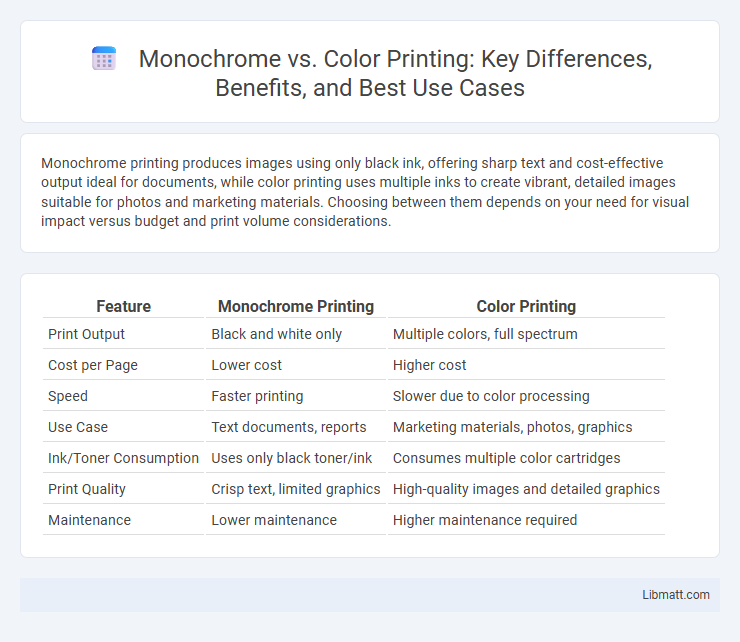Monochrome printing produces images using only black ink, offering sharp text and cost-effective output ideal for documents, while color printing uses multiple inks to create vibrant, detailed images suitable for photos and marketing materials. Choosing between them depends on your need for visual impact versus budget and print volume considerations.
Table of Comparison
| Feature | Monochrome Printing | Color Printing |
|---|---|---|
| Print Output | Black and white only | Multiple colors, full spectrum |
| Cost per Page | Lower cost | Higher cost |
| Speed | Faster printing | Slower due to color processing |
| Use Case | Text documents, reports | Marketing materials, photos, graphics |
| Ink/Toner Consumption | Uses only black toner/ink | Consumes multiple color cartridges |
| Print Quality | Crisp text, limited graphics | High-quality images and detailed graphics |
| Maintenance | Lower maintenance | Higher maintenance required |
Introduction to Monochrome and Color Printing
Monochrome printing produces images using shades of a single color, typically black, resulting in sharp text and high-contrast graphics ideal for documents and professional materials. Color printing utilizes multiple ink colors, combining cyan, magenta, yellow, and black (CMYK) to create vibrant, full-spectrum images essential for marketing materials, photographs, and detailed visuals. Understanding the difference between monochrome and color printing helps you choose the right method for your printing needs, balancing cost, quality, and purpose.
Key Differences Between Monochrome and Color Printing
Monochrome printing uses a single toner or ink color, typically black, producing sharp text and simple images with high contrast, ideal for documents and professional use. Color printing combines multiple ink colors, usually cyan, magenta, yellow, and black (CMYK), enabling vibrant and detailed images suitable for marketing materials and photographs. Monochrome printers offer faster printing speeds and lower costs per page, while color printers provide versatility and enhanced visual appeal at higher operational expenses.
Cost Comparison: Monochrome vs Color Printing
Monochrome printing typically costs significantly less per page than color printing due to the use of a single black toner or ink cartridge, which is more economical to produce and replace. Color printing requires multiple cartridges for cyan, magenta, yellow, and black, increasing the overall expense for ink and maintenance. Your choice between monochrome and color printing will impact your budget, especially if you print high volumes regularly.
Print Quality: Monochrome vs Color Output
Monochrome printing delivers sharp, high-contrast text and images ideal for documents where clarity and legibility are paramount. Color printing produces vibrant, detailed output suitable for photos and graphics, but may occasionally exhibit slight color variations affecting precision. Your choice should align with the importance of color accuracy versus crisp black-and-white reproduction in your print projects.
Typical Use Cases for Monochrome Printing
Monochrome printing is typically used for text documents, such as reports, invoices, and contracts, due to its cost-effectiveness and faster print speeds compared to color printing. It is ideal for environments where color is not essential, such as offices, schools, and legal settings, where clarity and legibility are priorities. Your choice for monochrome printing ensures professional and economical output suitable for high-volume document needs.
Common Applications of Color Printing
Color printing is widely used in marketing materials such as brochures, flyers, and posters to attract attention and convey brand identity effectively. It is essential for photographic reproductions, product packaging, and educational materials where visual accuracy and appeal are critical. Color printing enhances user engagement in presentations, advertisements, and digital media outputs by providing vibrant and realistic imagery.
Speed and Efficiency: Which Printing Method Wins?
Monochrome printing typically offers faster print speeds and greater efficiency compared to color printing, as it uses only black ink or toner, reducing the time required for ink drying and print processing. Your productivity benefits most when printing large volumes of text documents since monochrome printers have fewer components to manage and maintain, leading to lower operational costs. Color printing, while essential for vibrant graphics, slows down output due to multiple ink cartridges and complex color management, making monochrome the preferred choice for speed and efficiency in high-volume printing environments.
Maintenance Requirements for Each Printing Type
Monochrome printers typically require less maintenance due to simpler toner cartridges and fewer moving parts, reducing the likelihood of printhead clogging and color calibration issues. Color printers demand more frequent upkeep, including regular cleaning cycles and color alignment to prevent smudging and inaccuracies in output quality. Understanding your printing needs can help you manage maintenance schedules efficiently and extend the lifespan of your device.
Environmental Impact: Monochrome vs Color Printing
Monochrome printing consumes significantly less ink and toner compared to color printing, reducing the environmental burden associated with chemical production and disposal. Color printers typically require more energy and generate higher waste levels due to complex cartridges and frequent replacement cycles. Choosing monochrome printing minimizes resource consumption and supports sustainable office practices by lowering carbon footprints and waste output.
Choosing the Right Printing Solution for Your Needs
Monochrome printing offers cost-effective, high-speed output ideal for text-heavy documents, while color printing provides vibrant visuals crucial for marketing materials and presentations. Assessing your primary usage--such as volume, budget, and print quality requirements--helps determine the optimal choice between monochrome and color printers. Businesses prioritizing efficiency and lower operational costs typically select monochrome devices, whereas those requiring detailed graphics benefit from color printing solutions.
Monochrome vs color printing Infographic

 libmatt.com
libmatt.com